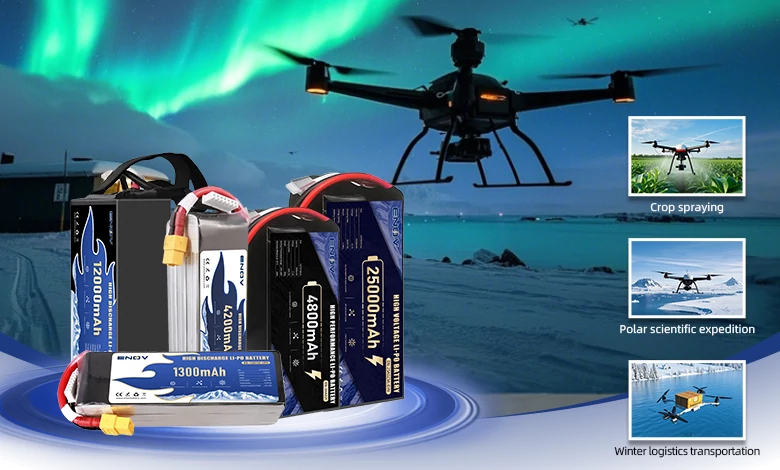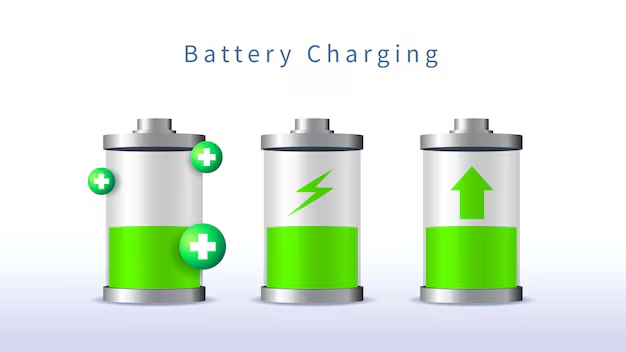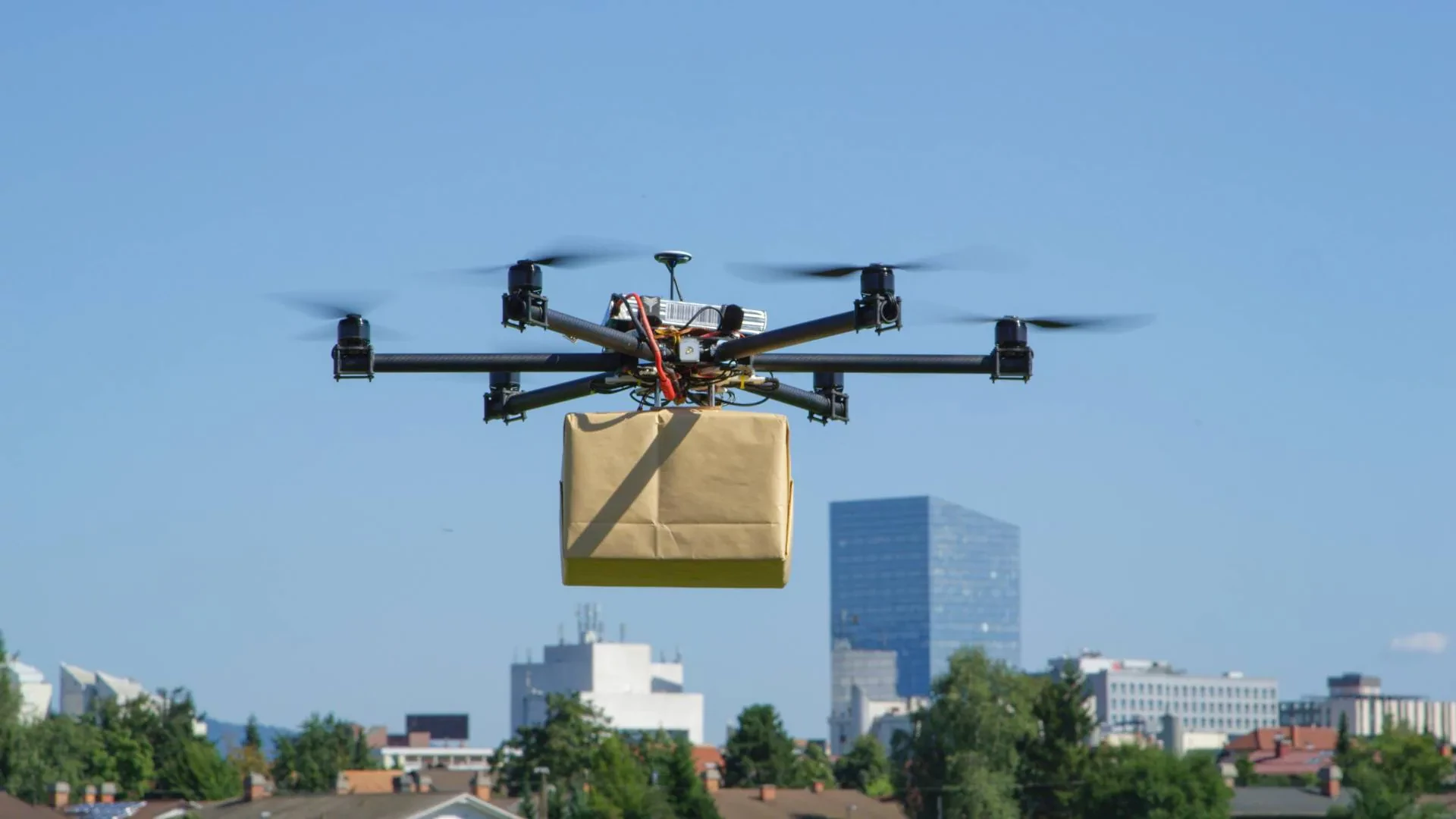Lithium Cobalt Oxide Battery (LCO)

ENOV High-Energy drone batteries power industrial and commercial drones. Delivering 220–320 Wh/kg energy density, they enable long flight times (30+ mins) and support fast charging (2C). Perfect for aerial photography, surveillance, and delivery drones.
1. Basic Definition and Core Composition of the Battery
The lithium cobalt oxide battery, commonly referred to as the LCO battery, is one of the earliest types of lithium-ion batteries to achieve commercialization, launched by Sony in 1991. Its core structural feature lies in the adoption of lithium cobalt oxide (LiCoO₂) as the positive electrode material, while graphite is typically used for the negative electrode. The charging and discharging functions are realized through the migration of lithium ions between the positive and negative electrodes. Currently, it is widely applied in the 3C consumer electronics field, and an upgraded form, namely the lithium cobalt oxide polymer battery, has also been developed.
2. Working Principle
(1) Core Mechanism
The charging and discharging process of a battery essentially involves the cyclic intercalation and deintercalation of lithium ions between the positive and negative electrodes. Simultaneously, electrons flow directionally in the external circuit to achieve energy transfer.
(2) Charging Process
Positive Electrode Reaction: Lithium cobalt oxide (LiCoO₂) decomposes to form Li₁₋ₓCoO₂ in a lithium-deficient state, while releasing lithium ions (Li⁺) and electrons (e⁻). The reaction formula is LiCoO₂ = Li₁₋ₓCoO₂ + xLi⁺ + xe⁻.
Ion Migration: The released lithium ions move towards the negative electrode through the electrolyte and separator; electrons flow to the negative electrode via the external circuit.
Negative Electrode Reaction: At the negative electrode, electrons, lithium ions, and graphite combine to form LixC6. The reaction formula is 6C + xLi⁺ + xe⁻ = LixC6, thus completing the charging process.
(3) Discharging Process
Negative Electrode Reaction: The LixC6 formed during charging decomposes, re-releasing lithium ions and electrons. The reaction formula is LixC6 = 6C + xLi⁺ + xe⁻.
Ion and Electron Flow: Lithium ions pass through the electrolyte and separator again to return to the positive electrode, and electrons flow to the positive electrode through the external circuit to supply power to external devices.
Positive Electrode Reaction: Lithium ions, electrons, and Li₁₋ₓCoO₂ combine to regenerate LiCoO₂. The reaction formula is Li₁₋ₓCoO₂ + xLi⁺ + xe⁻ = LiCoO₂, completing the discharge cycle.
(4) Relationship between Structure and Ion Migration
Lithium cobalt oxide has a layered crystal structure. Cobalt atoms and oxygen atoms form a covalently dense layer (main crystal layer) through covalent bonds, and lithium elements are located between two cobalt oxide layers (intercrystalline layers). Under an appropriate voltage, lithium ions can be easily intercalated into and deintercalated from the interlayers, and lithium ions can bind the negatively charged oxygen layers through electrostatic attraction. However, the excessive deintercalation of lithium ions can lead to irreversible phase transitions of the crystal. Therefore, a portion of lithium ions must be retained in the crystal lattice. Usually, 4.2V is used as the cut-off voltage, at which the capacity is approximately 140mAh/g, maintaining a stable state.
3. Performance Characteristics
(1) Advantages
● Excellent Energy Density: The theoretical specific capacity is approximately 274mAh/g, and the practical application capacity ranges from 140 to 160mAh/g. The volumetric energy density is particularly prominent, with a compaction density of 2.4-3.2g/cm³. It can provide a large amount of electricity in a compact size, making it suitable for devices with strict volume requirements.
● High Voltage Platform: The nominal voltage is 3.7V, and the discharge platform is stable and high (above 3.6V, with an initial voltage of approximately 3.9V). The energy density has a square relationship with the voltage platform. A high voltage platform enables higher energy density at the same capacity and better output power, allowing it to be applied in higher-power devices.
● Good Electrochemical and Processing Performance: The average capacity attenuation per cycle is less than 0.05%, the initial discharge specific capacity exceeds 135mAh/g, and the initial discharge platform ratio at 3.6V is greater than 85%. The high tap density helps to improve the volumetric specific capacity of the battery. The product has stable performance, good consistency, and a mature preparation process, making it suitable for large-scale production.
● Other Advantages: It has a small volume, light weight, and low self-discharge rate. Compared with steel-shell lithium-ion batteries of the same capacity, it is 40% lighter, and 20% lighter than aluminum-shell batteries. It also has the capability of high-current charging and discharging. The high-discharge-rate model can achieve a continuous discharge rate of 50C and a pulse discharge rate of 150C.
(2) Disadvantages
● High Cost: Cobalt is a rare metal with scarce resources and volatile prices, which directly leads to the high cost of the battery.
● Limited Cycle Life: The conventional cycle life is 300-500 cycles, and it can reach 500-1000 cycles in some scenarios. Deep charging and discharging will accelerate the structural collapse of the positive electrode material, and the cycle performance decreases more significantly under high voltage. For example, when charged to 4.6V, the capacity is only 50% remaining after 100 cycles at 1C rate, and only 20% remaining after 200 cycles.
● Poor Safety: It has poor thermal stability. In cases of overcharging, high temperature, or short circuit, lithium cobalt oxide is prone to decomposition and releases oxygen, which intensifies the risk of combustion and may cause thermal runaway. Therefore, it is necessary to be equipped with a protection circuit and a Battery Management System (BMS) to ensure safety. Additionally, problems such as overcharging or over-discharging are likely to occur in low-temperature environments.
● Low Specific Power: It performs poorly in high-load applications, which limits its use in high-power devices such as electric vehicles. Moreover, cobalt is toxic, posing a risk of environmental pollution.
4. Application Fields
(1) Core Application Scenario: Consumer Electronics
It is widely used in small electronic devices such as mobile phones, laptops, tablets (e.g., batteries for early iPhones and MacBooks), digital cameras, Bluetooth headsets, and smart wearable devices. Relying on its advantages of high energy density, small volume, and light weight, it has become an important power source choice for mid-to-high-end ultra-thin electronic devices.
(2) Other Application Scenarios
● Mobile Power Supplies: Due to the demand for high energy density, it remains one of the mainstream choices for some mobile power supplies.
● Drones and E-Cigarettes: These devices are sensitive to volume and weight and prefer lithium cobalt oxide batteries with high energy density. Some drones also use lithium cobalt oxide polymer batteries.
● Special Equipment: Such as medical implant devices (relying on the shape adaptability of lithium cobalt oxide polymer batteries), RC models, power tools, racing boats, emergency starting power supplies, and power sports equipment. In some scenarios, different forms of lithium cobalt oxide batteries are selected according to requirements.
(3) Application Limitations
Its application in large-scale scenarios such as electric vehicles and energy storage systems is limited, mainly due to its high cost, insufficient safety, and low specific power, which cannot meet the requirements of these scenarios for cost, safety, and continuous high-power output.
Quick inquiry
Drop us a line, and we’ll get back to you within 24 hours.

Ariana Yuan
Digital Operations Manager
Website Planning|Marketing Project Management for Drone Batteries|Scheduled Content Refresh|SEO Optimization

Ariana Yuan
Digital Operations Manager
Website Planning|Marketing Project Management for Drone Batteries|Scheduled Content Refresh|SEO Optimization




